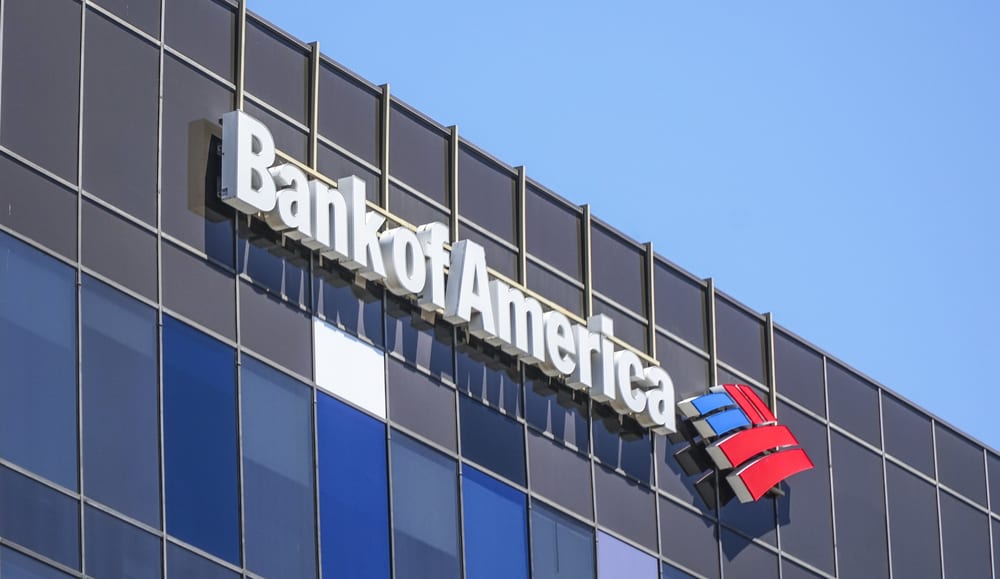
Bank of America Q1 2021 earnings beat forecasts with net income of $8.1bn for the three months to end March.
Revenue, net of interest expense, increases 0.2% y-o-y to $22.8bn. Noninterest income rises by 19% to $12.6nm, reflecting strong capital markets results. In addition, the bank posts higher investment and brokerage income. Moreover, provisions for credit losses fall by $6.6bn to a benefit of $1.9bn. This reflects a reserve release of $2.7bn amid an improved macro-economic outlook and balance declines.
On the other hand, ongoing margin pressure is taking its toll. Net interest income declines by an eye-watering 16% to $10.2bn, driven primarily by lower interest rates.
Bank of America Q1 2021 retail banking highlights
The bank’s retail banking focused Consumer Banking division posts net income of $2.7bn. Deposits soar by 25% y-o-y to $924bn. However, loans fall by 8% to $291bn. Record consumer assets rise by a whopping $112bn or 53% to $324bn. This is driven by market valuations and client flows of $25bn since the first quarter last year.
since Q1-20.
Bank of America has issued 473,000 Paycheck Protection Program loans to small businesses since inception. This includes 130,000 in the first quarter. And the loans equate to $21bn in outstanding balances. Furthermore, the bank reports further progress in boosting its digital banking metrics. It ends the first quarter with 70% of its customers actively using the bank’s digital platforms.
Bank of America Q1 2021: Merrill Lynch adds 6,400 net new households
The bank’s Global Wealth unit also posts a strong quarter. Specifically, it posts net income of $881m. Strong metrics include record client balances of $3.5trn, up $822bn, or 31%, driven by higher market valuations and positive client flows.

US Tariffs are shifting - will you react or anticipate?
Don’t let policy changes catch you off guard. Stay proactive with real-time data and expert analysis.
By GlobalDataTotal client balances of $3.9trn are up by 32% with deposits up 24% to $326bn. Meantime, loans are up 6% to $188bn. The bank’s Merrill Lynch unit adds 6,400 net new households, up 26% from the prior quarter. At the same time, the Private Bank added 675 net new relationships, up 74% from the past quarter.
Q1 digital banking highlights
The bank reports a 3% rise in active digital banking users to 40.3 million. Notably, digital sales now account for 49% of all retail banking sales. In the first quarter, customers made 2.6 billion digital log-ins. Zelle continues to go from strength to strength with 13.5 million active users. Users sent and received 170 million transfers worth $49.5bn, up 66% and 83% y-o-y respectively.
The bank’s distribution strategy relating to branches merits a mention. The bank is not using the pandemic to justify shrinking its physical footprint. On the contrary. Bank of America ends the first quarter with 4,324 branches, up by a net 27 outlets from a year ago.
The Merrill Lynch unit also reports strong digital growth. A record 80% of Merrill Lynch households are actively using an online or mobile platform. In addition, Merrill Lynch mobile app usage hits 40%, up from 31%.
Q1 less positive metrics
In summary, non-interest expenses and the bank’s cost income ratio move in the wrong direction. Noninterest expenses increase 14% to $5.1bn. This is driven largely by a $240m impairment charge for real estate rationalisation. At the same time, the bank incurs incremental expense to support customers and employees due to the pandemic. The cost income-ratio takes a hit, rising from 49% a year ago to a sobering 64%.
The Bank of America share price, at $39.88, is up 32.8% for the year to date, giving a market cap of $344bn.






